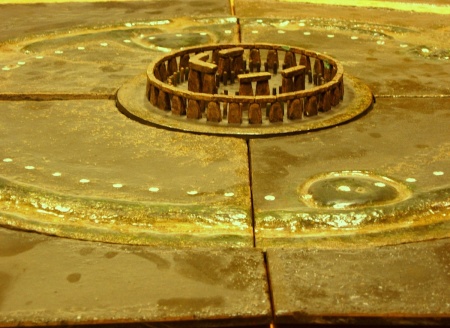A warm welcome to friend of the blog Burton Dasset, and thank you for permission to use this post, only slightly altered, from his blog, The Beaker Folk of Husborne Crawley!
…somebody put a sack over my head. I was thrown into a car, and driven for a number of hours, and then I was thrown out onto a beach. When I had pulled the bag off my head, I investigated the pain I had been suffering from in my chest. I discovered somebody had stapled an envelope to it. Inside the envelope was a chalet key, and the message “research the Henge”.
A henge? At Hemsby? How could it possibly be? And yet, there it was:
Its location took some time to understand. My first thought was that it was placed there, almost the most easterly point of England, to receive the first beams of the Summer Solstice sunrise. However, the enormous dunes that block off the henge from the eastern horizon suggest that this is not the case.
It is, however, close to a couple of bars, and very handy for the cafe next to the beach. On closer investigation, I was able to start to piece together some of the details of the way the Henge was created. It seems that the structure was built in three distinct phases. I call these Hemsby Stonehenge Phases I, II and III. However the man in the guardian’s hut referred to them as “9-hole, 12-hole and 18-hole”. He also claimed it was built in about 2003. Which is later than the Wiltshire Stonehenge, of course, but still – a 4,000 year old monument is quite something.
In fact, I suspect I may have found signs of an earlier-yet construction: for are these posts not remnants of the “Hemsby Woodhenge”, which predated the pink concrete version? The hole in the centre may be used for ritual purposes, akin to the Aubrey Holes at the Wiltshire version of this great monument.
And so we are left with a mystery. We may know where Hemsby Stonehenge is, we may be able to see the wondrous way the sun sets through the Great Trilithon, and over the chip shop opposite. But what can we make of the strange rituals of the Pilgrims at this monument? They walk around the Henge as if it is labyrinth – making strange swinging motions with their metal sticks, which gleam in the sunlight. Perhaps they are honouring their dead? Or is their clockwise path round the monument an homage to the sun’s diurnal journey? Are they walking alongside the sun? Or attempting to strengthen it – to bring back the long days of summer – maybe even encourage it to stay out for more than ten minutes at a time? Do the mats of green represent the world of life – while the gravel and stone-effect surroundings represent the world of the dead?
I believe that the ritual where the pilgrims roll small balls down a slope and into a brook represent the very act of passing over to the afterlife. Certainly, when they enact this ritual they say some very strong oaths. At other times, the Pilgrims seem to speak in strange tongues, or at least in code – for what could “That number 11 is never a par 2” possibly mean?
I have had a couple of pints of Old Speckled Hen and will now lay me down to rest in my little chalet to ponder further into these things. But I believe that it will always be with me – the mystery of the Hemsby Stonehenge.
Our heartfelt gratitude to Burton Dasset and whoever kidnapped him to Hemsby! For the curious, Clonehenge’s former mentions of the Hemsby golfhenge can be seen here, and here. Until next time, friends, happy henging!






